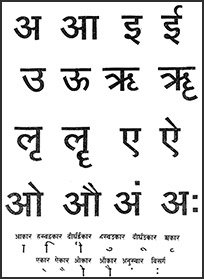Shyan, Śyan, Ṣyaṅ, Ṣyañ: 2 definitions
Introduction:
Shyan means something in Hinduism, Sanskrit. If you want to know the exact meaning, history, etymology or English translation of this term then check out the descriptions on this page. Add your comment or reference to a book if you want to contribute to this summary article.
The Sanskrit terms Śyan and Ṣyaṅ and Ṣyañ can be transliterated into English as Syan or Shyan, using the IAST transliteration scheme (?).
In Hinduism
Vyakarana (Sanskrit grammar)
Source: Wikisource: A dictionary of Sanskrit grammarŚyan (श्यन्).—A vikarana or conjugational sign of the fourth conjugation added to roots headed by दिव् (div), before the Sarvadhatuka affixes; e.g. दीव्यति, पुष्यति (dīvyati, puṣyati), etc. श्यन् (śyan) is added optionally with शप् (śap) (अ) to the roots भ्राश्, भ्रम्, क्लम् (bhrāś, bhram, klam) and others, as also to यस् (yas).
--- OR ---
Ṣyaṅ (ष्यङ्).—tad. affix य (ya) (taking Samprasarana change i e. ई (ī) before the words पुत्र (putra) and पति (pati) and बन्धु (bandhu) in the Bahuvrihi compound) added, instead of the affix अण् (aṇ) or इञ् (iñ), in the sense of offspring, (l) to words having a long (गुरु (guru)) vowel for their penultimate, only in the formation of feminine bases, e.g. कारीषगन्ध्या कौमुद्-गन्ध्या, वाराह्या (kārīṣagandhyā kaumud-gandhyā, vārāhyā); कारीषगन्धीपुत्रः, कारीष-गन्धीपतिः, कारीषगन्धबिन्धुः (kārīṣagandhīputraḥ, kārīṣa-gandhīpatiḥ, kārīṣagandhabindhuḥ) (Bah. comp.): cf P.IV.1.78; (2) to words expressive of family names like पुणिक, मुखर (puṇika, mukhara) etc. as also to the words क्रौडि, लाडि, व्याडि आपिशलि (krauḍi, lāḍi, vyāḍi āpiśali) etc. and optionally to the words दैवयज्ञि (daivayajñi) and others in the formation of feminine bases; e. g. पौणिक्या, मौखर्या, क्रौड्या, व्याड्या, आपिशल्या (pauṇikyā, maukharyā, krauḍyā, vyāḍyā, āpiśalyā) etc.: cf. P. IV.1.79, 80, 81.
--- OR ---
Ṣyañ (ष्यञ्).—tad. affix (1) in the sense of 'nature ' applied optionally with the affix इमनिच् (imanic) to words showing colour as also to words headed by दृढः (dṛḍhaḥ) e. g. शौक्ल्यम्, शुक्लिमा, कार्ष्ण्यम् कृष्णिमा, दार्ढ्यम्, द्रढिमा (śauklyam, śuklimā, kārṣṇyam kṛṣṇimā, dārḍhyam, draḍhimā) etc.: cf. P. V. 1.123: (2) in the sense of nature as also in the sense of professional work to words of quality and words headed by ब्राम्हण् (brāmhaṇ); e. g. जाड्यम्, ब्राह्मण्यम् (jāḍyam, brāhmaṇyam) cf P.V. 1.124; (3) to the words चतुर्वर्ण, त्रिलोकी (caturvarṇa, trilokī) and others in the same sense as that of those very words; e.g.चातुर्वर्ण्यम्, त्रैलोक्यम्, षाड्गुण्यम्, सन्यम् (cāturvarṇyam, trailokyam, ṣāḍguṇyam, sanyam) etc, cf. P. V. 6.124 Vart, 1.

Vyakarana (व्याकरण, vyākaraṇa) refers to Sanskrit grammar and represents one of the six additional sciences (vedanga) to be studied along with the Vedas. Vyakarana concerns itself with the rules of Sanskrit grammar and linguistic analysis in order to establish the correct context of words and sentences.
Languages of India and abroad
Sanskrit dictionary
Source: Cologne Digital Sanskrit Dictionaries: Monier-Williams Sanskrit-English DictionaryŚyan (श्यन्):—(in gram.) a technical term for the syllable ya (inserted after the root in the 4th class of verbs).
Sanskrit, also spelled संस्कृतम् (saṃskṛtam), is an ancient language of India commonly seen as the grandmother of the Indo-European language family (even English!). Closely allied with Prakrit and Pali, Sanskrit is more exhaustive in both grammar and terms and has the most extensive collection of literature in the world, greatly surpassing its sister-languages Greek and Latin.
See also (Relevant definitions)
Starts with: Shyana, Shyanabhaga, Shyanabhava, Shyanabhoga, Shyanapulina, Shyane, Shyanubhoga, Shyanubhogike, Shyanyatana.
Ends with: Apashyan, Makishyan, Piracishyan, Rishyan, Shishyan, Vipashyan.
Full-text (+372): Anugatya, Autkarshya, Maurkhya, Dhairya, Stainya, Maukharya, Anukulya, Vairupya, Svacchandya, Dharshtya, Abhimukhya, Pashyat, Caitanya, Prapashyat, Vinashyat, Sampashyat, Nashyat, Prativipashyati, Pranashyat, Prasarya.
Relevant text
Search found 8 books and stories containing Shyan, Śyan, Ṣyaṅ, Ṣyañ; (plurals include: Shyans, Śyans, Ṣyaṅs, Ṣyañs). You can also click to the full overview containing English textual excerpts. Below are direct links for the most relevant articles:
Padarthadharmasamgraha and Nyayakandali (by Ganganatha Jha)
Text 111 < [Chapter 6a - On Qualities]
Vakyapadiya of Bhartrihari (by K. A. Subramania Iyer)
Verse 3.14.177 < [Book 3 - Pada-kāṇḍa (14): Vṛtti-samuddeśa (On Ccomplex Formation)]
Verse 2.179 < [Book 2 - Vākya-kāṇḍa]
Verse 3.5.1 < [Book 3 - Pada-kāṇḍa (5): Guṇa-samuddeśa (On Quality)]
Amarakoshodghatana of Kshirasvamin (study) (by A. Yamuna Devi)
Deviation from convention (Introduction) < [Chapter 6 - Grammatical Aspects]
Brahma Sutras (Nimbarka commentary) (by Roma Bose)
Brahma-Sūtra 1.2.8 < [Adhikaraṇa 1 - Sūtras 1-8]
The Agni Purana (by N. Gangadharan)
Manusmriti with the Commentary of Medhatithi (by Ganganatha Jha)
Verse 7.1 < [Section I - Important Position of the King (rājan)]